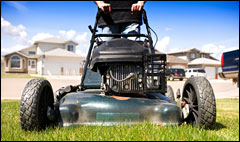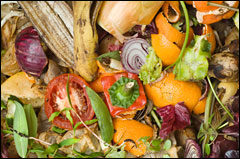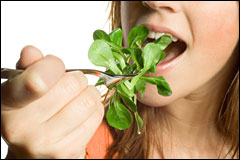
One of the most enduring truisms on earth is that all you need — aside from love, of course — is loam. Good dirt and a few seeds can get you a plot of paradise, whether you’re nursing daffodils in a window box, planting a native tree, or cultivating carrots, cukes, and Incredible Hulk-sized zucchini in a perfectly preened organic garden.
Go a few steps further — grab a rake, shovel, spade, soaker hose, hemp gardening hat, and grubby gloves — and shazzam, you’ve got beauty and the feast: a flower-filled haven that sprouts delicious organic eats.
Given this kind of payoff, it’s not surprising that about 70 percent of American households spend time gardening and caring for lawns. And the greening is increasing — in more ways than one. Eco-alternatives to yesterday’s toxic practices abound; now there’s never a need to poison the soil, water, flora, fauna — or yourself. Just take a few easy steps, offer some tendril loving care, and watch the coolest growth cycle on the planet: one that yields food, trees, flowers, clean air, and healthier grounds for living.
Here’s how to start.

Level One: The Baby Step
Mow betta. Razing in the grass (apologies to Hugh Masekela) is a gas, and it shouldn’t be. America’s 30 million acres of lawns, many of them scalped regularly by smelly, loud, gasoline-powered mowers, are a huge source of CO2 and air pollution. One hour of this mowing can emit as many pollutants as driving a car 20 miles (and some say it’s equivalent to driving 100 miles or more). To mow in the right direction: Sharpen your mower blades for maximum efficiency and adjust them higher — to about 3 1/2 inches or so, depending on the grass. Longer grass shades out weeds, and retains more moisture. And if you’re in the market for a new or replacement mower, buy an energy-efficient electric or propane-powered model — or, better yet, get some emissions-free exercise with a sharp new affordable reel mower.
Level Two: The Next Steps
Test your dirt. Testing soil for pH, nitrogen, phosphorus, and other elements helps pinpoint and correct troubles, to keep your grounds fertile and pest-resistant. You can also test for lead, a potent toxin found in auto exhaust, industrial emissions, and dust or chips from pre-1980 housepaints (construction projects on old buildings are key sources of contamination). Nurseries, hardware stores, and garden catalogues sell soil test kits; for a more in-depth job, use a testing lab.
Don’t use poisons. American homeowners dump nearly 100 million pounds of toxic and cancer-causing pesticides on their lawns and gardens each year, wiping out scores of helpful creatures like microbes, bugs, and birds — not to mention exposing their own families to an avoidable backyard risk. For grub riddance, try organic alternatives like chinch bugs, sod webworms, or milky spore powder.
And remember, weedy yards don’t need deadly chemicals — they need boosters like richer soil. Healthy, nutrient-filled humus — especially when seeded with hardy native plants — is naturally capable of battling weeds, bugs, disease, and other insults. If you’re looking for more radical weed help, try infrared zappers or (if it’s legal) a hungry goat. For more ideas on ‘cide-free gardening, check out the detailed guide from New American Dream.

Create compost. Kitchen scraps, grass clippings, autumn leaves, and other organic throwaways can supercharge your soil with nutrients. Toss them in a bin or on a compost pile, and let bacteria (or worms) turn garbage into gold.
Waste not, water not. Plants and the planet do best with less. Early morning watering is optimal; avoid watering from about 10 a.m. to 6 p.m., or whenever the sun is hottest. As a general rule, give H2O only once a week for no more than four hours; use soaker hoses or drip irrigation (since sprinklers waste twice as much water); and, for extra credit, use rain from collection barrels or household gray water from the tub or sink. (For more tips, see Umbra’s advice on watering the yard.)

Level Three: The Big Step
Go whole hog. Becoming a devoted organic gardener — and growing major amounts of your own natural food — could hardly be more sustaining and mouthwateringly satisfying. But succeeding at it takes time, effort, and, well, plotting. There’s eco-planning to do, compost to make, soil microbes to fret about, and insects (hello, ladybugs) to befriend. There are also bountiful returns, of course. Organic gardens amp up the flavors and nutrients in food, reduce our exposure to the nasties in conventional groceries, conserve and protect the landscape — and give us a great excuse to get dirty.
If more of us dig in, we’ll safeguard the planet and blast our veggie intake into the stratosphere (did we mention those Frankenstein-sized zucchinis?). It’s an orbit that’s worth trying.
Resources
Mowing and mowers
Consumer Reports
EPA Mower Emissions Calculator
People Powered Machines
Pesticide/herbicide info and alternatives
Beyond Pesticides
Northwest Coalition for Alternatives to Pesticides
A Living Lawn [PDF]
SafeLawns
Goat World
New American Dream Organic Pest Control Guide
Soil testing info and services
The Green Guide
Biological Urban Gardening Services (BUGS)
You Bet Your Garden
University of Massachusetts
Composting
The Organic Gardener
Earth 911
Organic gardening guidance
Garden Simply
Organic Landscape Alliance
GreenWeb
SustainLane
The Gardener’s Network


